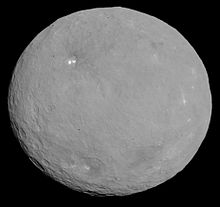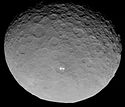
Ceres Polar Lander (CPL) is a European mission concept for a lander to Ceres that would search for biosignatures. [1] Published in 2008, the concept calls for a low-cost mission using reliable existing technology to complement other larger missions. [2] The original concept of the mission was to search for water ice and signs of life in permanently shadowed craters near Ceres' north pole. [2] However, with new information from the Dawn mission, it is now thought that water ice can be found on other locations on Ceres and that Occator crater may be a more desirable scientific target. [3]
If funded and launched, it would take about four years to reach Ceres, assuming a launch by a Soyuz rocket. [1]
References
- ^ a b Pullen, Lee (16 April 2009). "New Lander Could Probe Dwarf Planet Ceres For Life". Space.com. Retrieved 12 March 2019.
- ^ a b Poncy, J; Grasset, Oliver; Martinot, V; Gabriel, Gabriel (September 2008). "Preliminary assessment of a Ceres Polar Lander mission". European Planetary Science Congress: 403. Bibcode: 2008epsc.conf..403P.
- ^ Weitering, Hanneke (5 November 2018). "Now That Dawn Is History, Should NASA Send Another Mission to Ceres?". Space.com. Retrieved 14 March 2019.

Ceres Polar Lander (CPL) is a European mission concept for a lander to Ceres that would search for biosignatures. [1] Published in 2008, the concept calls for a low-cost mission using reliable existing technology to complement other larger missions. [2] The original concept of the mission was to search for water ice and signs of life in permanently shadowed craters near Ceres' north pole. [2] However, with new information from the Dawn mission, it is now thought that water ice can be found on other locations on Ceres and that Occator crater may be a more desirable scientific target. [3]
If funded and launched, it would take about four years to reach Ceres, assuming a launch by a Soyuz rocket. [1]
References
- ^ a b Pullen, Lee (16 April 2009). "New Lander Could Probe Dwarf Planet Ceres For Life". Space.com. Retrieved 12 March 2019.
- ^ a b Poncy, J; Grasset, Oliver; Martinot, V; Gabriel, Gabriel (September 2008). "Preliminary assessment of a Ceres Polar Lander mission". European Planetary Science Congress: 403. Bibcode: 2008epsc.conf..403P.
- ^ Weitering, Hanneke (5 November 2018). "Now That Dawn Is History, Should NASA Send Another Mission to Ceres?". Space.com. Retrieved 14 March 2019.

